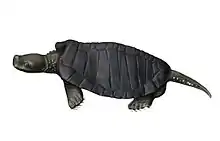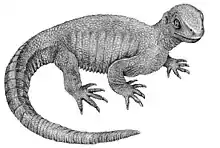| Mesochelydia Temporal range: | |
|---|---|
 | |
| Kayentachelys | |
| Scientific classification | |
| Domain: | Eukaryota |
| Kingdom: | Animalia |
| Phylum: | Chordata |
| Class: | Reptilia |
| Clade: | Pantestudines |
| Clade: | Testudinata |
| Clade: | Rhaptochelydia |
| Clade: | Mesochelydia Joyce, 2017 |
| Subgroupings | |
| |
Mesochelydia (from Greek mesos "middle" and chelys "turtle") is a clade within Pantestudines, more inclusive than Perichelydia, but less than Testudinata. The clade is known from the Early Jurassic to the Present, and contains all Jurassic representatives of Testudinata aside from Australochelys.[1] The ancestral condition for Mesochelydia is thought to be aquatic, as opposed to terrestrial for Testudinata.[2] They are distinguished from more basal testudinatans by the presence of the following characters: strap like pectoral girdle, supramarginals absent, reduced posterior entoplastral process, eleven pairs of peripherals, elongate processus interfenestralis, paired basioccipital tubercles, fully formed cavum tympani and antrum postoticum, single vomer, confluent external nares, lacrimals and supratemporals absent.[1]
Taxonomy
- Condorchelys Sterli, 2008 Cañadón Asfalto Formation, Toarcian, Argentina
- Eileanchelys Anquetin et al. 2009 Kilmaluag Formation, Bathonian, Scotland
- Heckerochelys Sukhanov, 2006[3] Moskvoretskaya Formation, Bathonian, Russia
- Indochelys Datta et al., 2000[4][5] Kota Formation, Toarcian, India
- Kayentachelys Gaffney et al. 1987 Kayenta Formation, Sinemurian, United States
- Perichelydia Joyce, 2017 Middle Jurassic-Present, Worldwide
Additionally, an indeterminate basal non-perichelydian mesochelydian taxon is known from the Early Cretaceous Batylykh Formation in Russia.[6]
References
- 1 2 Joyce, Walter G. (April 2017). "A Review of the Fossil Record of Basal Mesozoic Turtles". Bulletin of the Peabody Museum of Natural History. 58 (1): 65–113. doi:10.3374/014.058.0105. ISSN 0079-032X. S2CID 54982901.
- ↑ Sterli, Juliana; de la Fuente, Marcelo S.; Rougier, Guillermo W. (2018-07-04). "New remains of Condorchelys antiqua (Testudinata) from the Early-Middle Jurassic of Patagonia: anatomy, phylogeny, and paedomorphosis in the early evolution of turtles". Journal of Vertebrate Paleontology. 38 (4): (1)–(17). doi:10.1080/02724634.2018.1480112. ISSN 0272-4634. S2CID 109556104.
- ↑ V. B. Sukhanov. 2006. An archaic turtle, Heckerochelys romani gen. et sp. nov. from the Middle Jurassic of Moscow region, Russia. Fossil Turtle Research 1:112-118
- ↑ Datta, P.M.; Manna, P.; Ghosh, S.C.; Das, D. P. (April 2000). "The First Jurassic turtle from India". Palaeontology. 43 (1): 99–109. doi:10.1111/1475-4983.00120. ISSN 0031-0239.
- ↑ Joyce, Walter G.; Bandyopadhyay, Saswati (2020-02-11). "A reevaluation of the basal turtle Indochelys spatulata from the Early–Middle Jurassic (Toarcian–Aalenian) of India, with descriptions of new material". PeerJ. 8: e8542. doi:10.7717/peerj.8542. ISSN 2167-8359. PMC 7020818. PMID 32095362.
- ↑ Skutschas, Pavel P.; Markova, Valentina D.; Kolchanov, Veniamin V.; Averianov, Alexander O.; Martin, Thomas; Schellhorn, Rico; Kolosov, Petr N.; Grigoriev, Dmitry V.; Vitenko, Dmitry D.; Obraztsova, Ekaterina M.; Danilov, Igor G. (February 2020). "Basal turtle material from the Lower Cretaceous of Yakutia (Russia) filling the gap in the Asian record". Cretaceous Research. 106: 104186. doi:10.1016/j.cretres.2019.07.016. S2CID 202195840.
